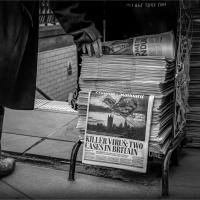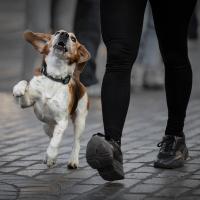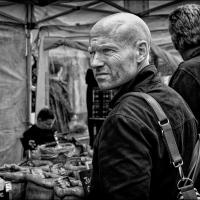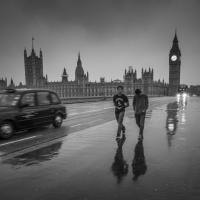THE LAW ON PHOTOGRAPHY - OUTDOORS DAVE HIPPERSON
With more and more people becoming ‘street’ photographs whether deliberately, or not in some cases, it might be wise to re-cap some of the generally held beliefs, misunderstandings and myths surrounding legality of taking photographs in public places. Many People are very shy of taking snaps out of doors now and they do not have to be. You have to be doing something very exceptional to actually break the law.
Some history. Lets start by looking at this from the police’s point of view. A few years ago when so called terrorism threats seemed to be at their highest the police on our streets got rightly jumpy. There were incidents of completely law abiding citizens being stopped and even arrested for perfectly innocent private or domestic photography – not even for financial gain – just taking pictures for themselves, often of themselves. You may remember the case of the BBC Journalist who was ’stopped’ for taking a photograph of St Pauls Cathedral one pleasant Summer evening. In many ways we have him to thank for drawing these over reactions to public attention as he did not go quietly. Around that time, ten years or so ago, many people were being unlawfully harassed by the police and other law ‘enforcement organisations’. This happens much less now. You are more likely to have trouble with poorly informed members of the public which can be more dangerous.
Most of the police’s excess zealotry revolved around the Section 44 Stop and Search when extended under the Terrorism Act. This still exist but has been softened somewhat in view of the large number of wholly unjustifiable cases of ‘stopping’ the general public and the resultant outcry.
Clearly Stop & Search powers are something which the police need particularly in certain parts of London to deal with their unending battle against knife and gun crime which thrives on the trafficking of illegal drugs mostly amongst ethnic populations. However you and I are more concerned with the possibilities of being stopped for a suspected Terror offence because you might be carrying suspicious looking hand luggage (camera cases) or wondering around seemingly lost looking up at buildings or have pointed a camera at a police man from very close range. To stop you now, the police really do have to have a good reason and even then their hands are tied. I must presume that the persons I am addressing (you) are not terrorists of any kind and don’t expect to become one in the near future. Therefore I will return to what the police can tell us we can or cannot do in a moment. Generally they are the more reliable component in this equation. They too are governed by Laws.
What can we photograph in Public places? Truth is we have a pretty freehand. By Public I mean not Private – remember there is no such thing as Common Land as every inch of the UK belongs to somebody. There are also a lot of private places, which look public but are not. Owners of properties (or their appointed staff) can ask you to stop taking pictures and if you don’t, can ask you to leave, or eject you (maybe) or more likely get the police to do so. Some typical areas that are technically out of bounds include shopping precincts, cafes, pubs, restaurants, cinemas, theatres, the railway and the underground even just shops etc. That is not to say you can’t take pictures there it is just that the owners can ask you to stop. If you intend to do some photography in such places best to ask them first and explain why you want to do it and what you have in mind. I wanted to take some pictures in Tesco some years ago, of the fish counter of all things. Always so attractively laid out. The manager seemed positively flattered that someone was interested and was no problem at all.
A great deal of the ground around large fancy modern skyscrapers in London is controlled by the buildings owners even though it looks like public space and is open to the public. Areas around Canary Wharf and other such modern developments are a perfect example. If you fall foul of private restrictions you are likely to come into contact with hired security personel who often can be less polite, shall we say, than the police. Beware such areas. There are even parts around the London Eye that are actually private property but on which the public is allowed, even encouraged, to walk. Places like this can stop you taking pictures – mainly they don’t but be aware you might be stopped. A sensitive area currently seems to be around and into door ways which can be accessed from a public vantage point. Heavies might get nasty if they think you might are casing the joint. Try to avoid these areas and their anger even if in truth you are legal where you are standing. It’s not worth antagonising them they are in defence mode at all times you are just pursuing your hobby – back off. Similarly it is best you are careful when recording what might be the aftermath of a crime or at least a serious incident. The police have every right to impede your access if they are conducting a search of a crime scene as you could disturb vital forensic evidence. That’s what all that blue and white tape is about.
As long as you are not standing on private property you can take pictures of anyone doing anything. Families, street traders, children, animals motor cars anything. You can totally ignore any private little signs set up suggesting you can’t. In effect people that come out into the public domain are fair game. Those that don’t want to be photographed should stay at home. Simple as that. That’s the law.
There are provisos. If you chase a person with your camera or push a camera into their faces or do similar when they are say eating alfresco they have every right to complain as that is harassment and an invasion of privacy, a different crime. Long range lens of them naked on a quiet but public beach isn’t, but popping a camera over their garden fence is. It’s then not so much to do with the camera more as to do with their space.
Because of recent advances in technology it is easier to take secret images such as with your phone hand held or on a stick. Most of these are fine too but not in one particular case. TheVoyeurism Act was passed. (I know yet another law) on 12th April 2019. As it seems some unscrupulous people were using the phones mounted on sticks to take pictures up women’s skirts. (If they could find any women wearing skirts.) This is a really niche area and like the dangerous dogs act a knee jerk reaction to something which was hardly an epidemic but simply a cause championed by a pressure group. However it now has genuinely criminalised one particular way of using a camera in the quest for one sort of picture. I could explain why it is so stupid a law and so impossible to police and so open to miss-interpretation and doubtless miss use but I don’t have space here. Suffice it to say it’s now illegal to take or attempt to take non consensual images up women’s skirts either accidentally or by design. Yet another difficult one for the police as if they hadn’t got enough unworkable laws to enforce already.
The Police are the police and although they have to give you a reason to stop you they can anywhere if need be. The chances of this happening now are much less than they were but be advised. Generally the police will only get anxious if they think you are taking images that might in some way impeded the due process of law. In other words getting in their way. They can of course easily interpret this as having a camera pointed straight at them aggressively at close range. They can also ask you to stop if they think that you might be taking pictures to use to assist some future act of terrorism. Reconnoitering possible bombing sites was quoted in the past but in truth the really dangerous criminals do that with Google Maps. Now, even though the Police have still got a wide remit they can’t just make stuff up as they have to explain later in court why they did what they did. That’s what all the paperwork is about that the average layman complains about. However they can use this to make your life difficult. Photographing at protest rallies I would say would be where you might start to expect this sort of treatment if unlucky. Not illegal but it’s where misunderstandings can start. You have every right to photograph them in their daily duty, even at protest events (please wear your mask otherwise they may arrest you for that.) but just photography don’t use your camera like a weapon. Personally I would avoid attending demonstrations where there is likely to be violence if only to protect your equipment if not you own well being.
The Police have no authority to require you to show them any images, or hand over your camera equipment or delete any of your images if you have been taking them from a public position. Even if you are arrested they have to get a court order before they can delete your images. The basic ground rules that apply are:-
If you are stopped as a pedestrian you do not have to give them your name, address date of birth or anything like that. You don’t have to explain where you have been or where you are going. You only have to give those details if they arrest you. Paradoxically I can see that a malevolent attitude on your part, regarding such questioning may provoke them into believing you are up to something and then they might arrest you. Lots of time wasted for everyone. So be as courteous to them as you might when meeting anyone on the street. It will save you both lots of time.
If you are unlucky enough as to have provoked them and they evoke Sec 44 Stop & Search they have the power to pat you down for weapons and drugs, remove anything concealing your identity, seize any articles thought to be connected to potential terrorism and look through your pockets.
If this ever happens to you then you should always first insist on a written record of the search and what they have done. Legibly written confirming precisely why you were being stopped and with the officer’s number on it. (Remember that they know you can do this so they won’t go around stopping and searching at random.) Ensure you see the officer’s warrant card and note it’s number as well as their epaulet numbers as these will be useful if having to trace them later on to make a compliant, if had they moved stations. You can’t have too much information. It’s knowing to do this and what to do in advance that might make for a much happier time for you at the hands of the police. They try it on sometimes but they also realise quickly when they are up against some one who knows the law. Never get cocky it will just prolong the agony. Community support officers (plastic policemen) cannot do Stop & Search by the way, only full officers.) None of them nor any member of the public can demand your camera or the SD card or under any circumstances delete your images. Not without a court order at the very least.
So in the main you are clear to take just about anything with anything you like when in public areas. However antagonising strangers is never a good idea either. If you do it to the police you may be delayed. If you do it to a vile tempered member of the public you may end up in a bigger mess with a lot broken camera equipment to sue for. Trouble with this is now you know the law but a great deal of the population out there don’t including some people with young families who think they can come out and flaunt about with their semi-naked children in a public park and tell everyone with a camera to go away. They cannot do this and if you do happen to take such pictures it is not illegal, only if you invade their personal space and/or their privacy. Probably best to simply avoid young children particularly if semi naked playing in ponds and fountains – not your fault it just that there are lurkers about that make people’s lives difficult and they have got us a bad name. Uninformed members of the public can get mighty lippy and worse. Keep calm and remember your rights. Do not get involved in a slanging match but it might do no harm to quote them the law as that will then be one less ignorant person on the street. Sometimes you will have to walk away to avoid a confrontation but remember you have the right to photograph whoever you want.
I have a professional photographer and competition judge friend who tells the lovely story of his attempts to take a sunset shot along a beach one evening on the South Coast only to have the parent of one of the children in a small and quite distant group right next to the water ask him to stop. He explained to said parent that he was about to ask him if he wouldn’t mind removing his child from the beach as it was spoiling his composition! You wont always be able to think that quickly!
Dave Hipperson
The author must point out that he is not legally qualified and cannot be held responsible for situations arising from anything he might have said here. His advice is from his own experience and recent research into the matter.
‘A MOMENT IN TIME. Taken on 31st JAN 2020 by the Chairman of the Harpenden Camera Club Steve Collins who went to London on that day to report on the UK leaving the EU. He got another story as well. At the time he was disappointed that it conflicted with the one he had gone to report– on reflection he had captured a unique moment in Global history in one snap! It can never be repeated.
‘SHOAL OF TESCO’S MACKERAL. Just a comfortable composition. But I got permission from the manager before I took it. (Dave Hipperson.)
‘BEST PAW FORWARD.’ Lloyd Moore President of Watford Camera club captured this perfect street shot. The paw and possibly more importantly the left foot of the lady owner off the ground accentuate the moment. Notice the low camera angle – dangerous if she had been wearing a skirt now!
‘MAN AT THE MARKET.’ Truly fine portraiture here. This fellow captured in situ as a customer. Great character in his face. Very difficult to get such clarity in a Street Shot. (Terry Day.)
WESTMINSTER BRIDGE. It was at 4:40 am on Mid Summer Night 2019. Raining in London of course. This is by Will Cheung, excellent photographer and editor of Photography News. Everything is exactly the right place – including the photographer. It’s tough being up at these hours but if you want images like this you have do it.





